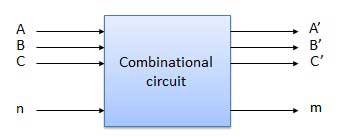🟢Introduction
🔹The major difference between combinational and sequential logic circuits is that the combinational logic circuit consists of only logic gates while the sequential logic circuits consist of logic gates and memory elements.
🔹Another crucial factor which differentiates combinational and sequential logic circuits is the state of output elements. The state of the output elements of the combinational circuit depends on only the present state of the input elements. On the contrary, the output obtained from a sequential circuit depends on the present state of the input as well as the past state of the output.
🟢Comparison Chart

🟢Combinational Logic Circuit
🔹Because the combinational logic circuit is made up of logic gates, the output is directly tied to the input. In the case of the Combinational logic circuit, there are no feedback elements. The term combinational comes from the word combination, which indicates two or more parts combined in a single process.

🟢Sequential Logic Circuit
🔹The sequential logic circuit also involves memory elements along with the logic gates. Thus, the output generated by the sequential circuit depends not only on the present state of the input but also on the previous outputs.

🔹The sequential circuit involves the usage of feedback loops, with the help of this the state of the previous output is recorded. Thus, the next output is controlled by the state of the previous output. The memory present in the sequential circuit keeps the track of the output and thus, the output is produced.
🔹The word sequential is derived from the word sequence which means in a definite order. To understand the operation of the sequential circuit let’s take an example of television circuitry. The television is also a type of sequential circuit. The keys available in the remote to change the channel or up and down keys to adjust the volume, this entire process is sequential.
🔹When you select a particular channel the Television receiver keeps the track of the previously selected channel and according to that, the next channel is selected.
🔴The Most Important Differences Between Combinational and Sequential Logic Circuits
🔹Both combinational and sequential logic circuits are the building blocks of digital circuits, but the existence of memory elements makes a significant difference. The combinational logic circuit lacks memory elements, whereas the sequential logic circuit has memory elements.
🔹The output of a combinational logic circuit and a sequential logic circuit differs as well. The output of the combinational circuit is solely a function of the current inputs. However, the output of the sequential circuit is dependent on both the current input and the previous output.
🔹In the case of combinational logic circuits, the feedback loop is absent. However, it must be present in the sequential logic circuit in order to track the previous output.
🔹The Clock signal is not used in the combinational circuit but sequential uses the clock to provide synchronization.
🔹The designing process of the combinational circuit is much simple as compared to that of the sequential circuit.
🔴What do we miss in combinational logic?
•We need something which remembers one bit of information from time t-1 so that it can be used at time t
•Remembering either state 0 or 1
•Remembers by flipping between 0 and 1 state
•Gates that can do this flip between two states are called Flip-Flops
🟢Conclusion
The combinational and sequential logic circuits are intended for a variety of applications. However, most circuits use a blend of combinational and sequential circuits to satisfy their objectives. The output of the combinational circuit will be determined by the function of the input. The sequential circuit, on the other hand, will generate the output depending on the state of the memory element. It keeps track of the previous inputs and outputs.

